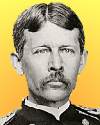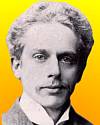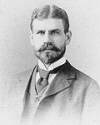
On 13 Sep 1851, Walter Reed was born, the American military surgeon, pathologist and bacteriologist who led the experiments that proved that disease was transmitted by the bite of a mosquito. Thereafter sanitary efforts to eradicate mosquitos, and protection from their bite, eliminated epidemics. Of Walter Reed's 51-year life, only twelve were spent in the study which made him famous. His name remains known today, because of the major hospital named for him.
In Walter Reed: A Memoir (1904), you can read more of his accomplishments. He died from appendicitis in 1902. When Major William C. Borden operated on Reed, but could not save him, Borden worked to have a hospital named for Walter Reed. In 1951, on the 100th anniversary of the birth of Walter Reed, the yet larger installation was given its present name—the Walter Reed Army Medical Center. It serves the nation as a monument to a long tradition of patient care.

On 13 Sep 1833, Boston entrepreneur Frederic Tudor delivered the first imported ice to Calcutta from the USA, harvested from ponds frozen in winter. Today's book pick is: The Frozen Water Trade: A True Story, by Gavin Weightman who describes Tudor's fascinating enterprise before the time of refrigeration. This unknown part of history makes a rivetting read. Tudor created an industry and made a fortune. It began on 13 Feb 1806, when the brig Favorite left Boston harbor bound for the Caribbean island of Martinique with a cargo that few imagined would survive the month-long voyage. Packed in hay in the hold were large chunks of ice cut from a frozen Massachusetts lake. With this first venture, Frederic Tudor believed he could profit from selling ice to people in the tropics. Ridiculed at the outset, Tudor endured years of hardship before he was to fulfill his dream. Over the years, he and his rivals extended the frozen-water trade to Havana, Charleston, New Orleans, London, and finally to Calcutta, where in 1833 more than one hundred tons of ice survived a four-month journey of 16,000 miles with two crossings of the equator. The author provides a fascinating account of the birth of this unusual industry that ultimately revolutionized domestic life for millions of people.
It is available from Amazon, typically about New from $9.70. Used from $1.50. (As of earlier time of writing - subject to change.)
| no image | It is the business of science to offer rational explanations for all the events in the real world, and any scientist who calls on God to explain something is falling down on his job. This applies as much to the start of the expansion as to any other event. If the explanation is not forthcoming at once, the scientist must suspend judgment: but if he is worth his salt he will always maintain that a rational explanation will eventually be found. This is the one piece of dogmatism that a scientist can allow himself—and without it science would be in danger of giving way to superstition every time that a problem defied solution for a few years. |
| no image | Remarking about Frederick Sanger who used the new technique of paper chromotography: They are not chemists there, just a lot of paper hangers. |
 | We may fondly imagine that we are impartial seekers after truth, but with a few exceptions, to which I know that I do not belong, we are influenced—and sometimes strongly—by our personal bias; and we give our best thoughts to those ideas which we have to defend. |
| Before you look at today's web page, see if you can answer some of these questions about the events that happened on this day. Some of the names are very familiar. Others will likely stump you. Tickle your curiosity with these questions, then check your answers on today's web page. | |
| Births | |
 | An American manufacturer was born 13 Sep 1857 who in 1903 began building what became the world's largest chocolate manufacturing plant. He used his fortune philathropically. Can you name this man? |
 | Hans Christian Joachim Gram, a Danish pharmacologist and pathologist, born 13 Sep 1853, invented the Gram stain. What is the Gram stain's use? |
 | Walter Reed, born 13 Sep 1851, was a US Army pathologist and bacteriologist. In Jun 1900, Reed headed a board to investigate the infectious diseases of Cuba, and one in particular. The same disease invaded the U.S. ninety times, sweeping large and small towns. His work overcame further epidemics of that fatal disease. He died in 1902. Combatting which disease is regarded as his great achievement? What was its cause? |
| Deaths | |
 | Robert Hope-Jones (1859-1914) was a British-American organ builder whose innovations created the theatre organ and its orchestral sounds. He also patent a device still in use at lighthouses today. Which device used at lighthouses did he invent? |
| Events | |
 | On 13 Sep 1826, the first animal of its kind to be exhibited in the U.S. was shown at Peale's Museum and gallery of the Fine Arts in New York City. An advertisement described, “its body and limbs are covered with a skin so hard and impervious that ... it will turn the edge of a scimitar and even resist the force of a musket ball.” Which animal was this? |
 | In 1900, physician Jesse Lazear, at age 34, was bitten by a disease-carrying mosquito. He was in Quemados, Cuba, researching the transmission of that disease. His death, two weeks later, proved that the mosquito was the carrier of that disease. What disease caused the death of Lazear? |
Fast answers for the previous newsletter for September 12: polio • discovery of artificially produced radioactive elements • Thesaurus of English Words and Phrases (1852) • Mae C. Jemison • prehistoric art depicting animals which dated back to 15,000 BC.
 If you enjoy this newsletter, the website, or wish to offer encouragement or ideas, please send feedback by using your mail reader Reply button.
If you enjoy this newsletter, the website, or wish to offer encouragement or ideas, please send feedback by using your mail reader Reply button. Your click on a Facebook, StumbleUpon, or other social button on the site webpages is also a welcome sign of appreciation. Thank you for using them.
© This newsletter is copyright 2020 by todayinsci.com. Please respect the Webmaster's wishes and do not put copies online of the Newsletter — or any Today in Science History webpage. (If you already have done so, please remove them. Thank you.) Offline use in education is encouraged such as a printout on a bulletin board, or projected for classroom viewing. Online, descriptive links to our pages are welcomed, as these will provide a reader with the most recent revisions, additions and/or corrections of a webpage. For any other copyright questions, please contact the Webmaster by using your mail reader Reply button.
--
If you do not want to receive any more newsletters, Unsubscribe
To update your preferences and to unsubscribe visit this link
Executive Real Estate Business Class
-
"It was like a man with wings. It wasn't like anything you'd see on TV or in a monster movie." ...
About the publisher
Search This Blog
Blog Archive
-
▼
2020
(1542)
-
▼
September
(173)
- SCIENCE: Just how big is Everest?
- The Latest News from History News Network
- On This Day for September 30 - Munich Agreement si...
- We are called to return to our foundational values...
- Newsletter for Wednesday 30 September.
- They Killed His Wife And Left Him For Dead – Then ...
- TRAVEL: Telling new truths about America’s histori...
- Make learning fun with Nat Geo Kids magazine! Subs...
- On This Day for September 29 - British mandate in ...
- Newsletter for Tuesday 29 September.
- Special Edition: Dinosaurs come to life like never...
- September 29: On This Day in History
- HISTORY: America's most endangered historic sites
- New This Week on History News Network
- On This Day for September 28 - California “discove...
- Newsletter for Monday 28 September.
- September 28: On This Day in History
- FAMILY: What do I tell my kids about wildfires and...
- On This Day for September 27 - Norman Conquest beg...
- Newsletter for Sunday 27 September.
- September 27: The Rosetta Stone, E=mc² and Fear as...
- The Compass: Indonesia
- On This Day for September 26 - First televised U.S...
- Newsletter for Saturday 26 September.
- September 26: Frances Drake's Circumnavigation, th...
- CORONAVIRUS UPDATE: Is this the end of the office?
- PHOTOGRAPHY: They feed us. Now we see them.
- The assassination of Lord Mountbatten | Enola Holm...
- 39,500-Year-Old Cave Bear Discovered Perfectly Pre...
- On This Day for September 25 - Pacific Ocean sight...
- The Roundup Top Ten for September 25, 2020
- Newsletter for Friday 25 September.
- September 25: Battle of Stamford Bridge, Remote Co...
- ANIMALS: These mighty elephants find peace
- On This Day for September 24 - Federal troops sent...
- Newsletter for Thursday 24 September.
- Global cartels taking control of the world + HPA B...
- September 24: Decline of the Byzantine Empire, Ope...
- YOUR WEEKLY ESCAPE: America's oldest mystery
- SCIENCE: How to cope with a big death toll
- The Latest News from History News Network
- On This Day for September 23 - Neptune observed, J...
- Newsletter for Wednesday 23 September.
- September 23: Nintendo, the Start of Data Processi...
- TRAVEL: How will America’s state parks survive?
- Matching gift opportunity for Sumatran rhinos
- On This Day for September 22 - Solidarity formed, ...
- Newsletter for Tuesday 22 September.
- September 22: Salem Witch Trials, Iraq's Invasion ...
- HISTORY: Who can replace RBG?
- Feed their curiosity! Get Nat Geo Kids magazine fo...
- New This Week on History News Network
- On This Day for September 21 - Joseph Smith's visi...
- Newsletter for Monday 21 September.
- September 21: France, China and a Sheep Shearing R...
- FAMILY: Don’t tell your kids outdated stuff about ...
- On This Day for September 20 - Rome incorporated i...
- Pro-life is not Politics + Vickie Travis's message...
- Newsletter for Sunday 20 September.
- September 20: Attila the Hun, Magellan's Circumnav...
- The Compass: Chile
- Matching gift opportunity for Sumatran rhinos
- On This Day for September 19 - George Washington's...
- Newsletter for Saturday 19 September.
- CORONAVIRUS UPDATE: Young people are spreading the...
- September 19: 1st Country to Grant Women the Right...
- PHOTOGRAPHY: How to make dinos look new (CORRECTED)
- Quick Note: How to Save Videos by Downloading
- PHOTOGRAPHY: How to make dinos look new
- The Mayflower | Medieval spiders | Ancient Egypt f...
- When She Found Out Her Boyfriend Was A Serial Kill...
- The Roundup Top Ten from History News Network
- On This Day for September 18 - Mukden seized by Ja...
- Newsletter for Friday 18 September.
- "Truth Crushes Evil" + We're Winding down + What ...
- YOUR WEEKLY ESCAPE: The country that doesn't exist
- September 18: Great Fire of Moscow, the CIA and El...
- ANIMALS: How U.S. officials stopped the flying squ...
- Two New Podcasts From HISTORY
- Don't miss out: back to school savings for learner...
- On This Day for September 17 - Camp David Accords ...
- Newsletter for Thursday 17 September.
- September 17: Bloodiest Day in the American Civil ...
- SCIENCE: He found part of a one-of-a-kind dinosaur
- SPECIAL REPORT: How the West is primed to burn
- The Latest News from History News Network
- On This Day for September 16 - Mayflower's departu...
- Newsletter for Wednesday 16 September.
- September 16: French Abolish Slavery, Malaysia For...
- TRAVEL: Will slowing down help you get stronger?
- Special Report: How do we end this pandemic?
- On This Day for September 15 - Central Americans g...
- Newsletter for Tuesday 15 September.
- September 15: Darwin Reaches the Galapagos, Penici...
- HISTORY: How the U.S. battled catastrophic wildfir...
- BREAKING NEWS: Possible evidence of life found on ...
- Discover Remarkable Leaders With Nat Geo History M...
- On This Day for September 14 - Mexico City capture...
- New This Week on History News Network
- Newsletter for Monday 14 September.
-
▼
September
(173)
-
Blogroll
-
About
HistoryFact










0 comments:
Post a Comment